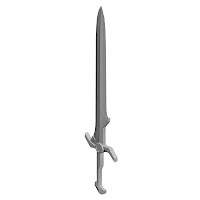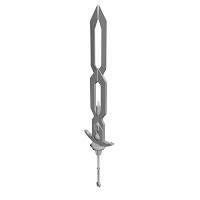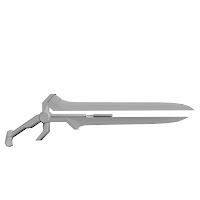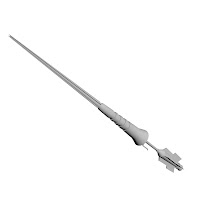Right, quick note about the formatting of these posts; I've been told that all my XB3002 blog posts need to be separated into Design and Research. Therefore, all future posts for this module will be marked as such. We clear? Good.
Anyway, if you can recall my last XB3002 post, I noted down the three game ideas that I intended to use for my first deliverable, the 3 concept documents. Well, over the last couple of weeks, I've been working on said documents, which brings us to today's post. So, here they are:-
Document 1: Turn Based Strategy
Document 2: Cooperative Platformer
Document 3: Business Simulation Game
As of now, I'm planning to use the Strategy game for the final Games Design Document. It's a genre I'm not familiar with, which should allow for more research, plus it has less potential for complications than, say, the platformer. I also feel that it'll allow me to explore the ethical side of cloning more effectively than the other concepts.
That about wraps up this post. Next post should include the project plan.
Wednesday, 30 January 2013
Thursday, 24 January 2013
XB3001 GAMES PROPOSAL #14: Preproduction Outline and Level Building Workflow
Well, the level design assignment is officially underway. Ironically (and unfortunately) I haven't really been able to make much headway with this particular task outside of our lectures, as I've been focusing on my Honours Project (still behind from Christmas...)
With that being said, we've all been neck-deep in lectures courtesy of Ben, who has been giving a ton of information to help us. This post will contain some of the stuff covered in his lectures.
The first stage of level design is Preproduction, which is essentially the planning step. It is divided into 8 individual steps:-
1. Idea - the initial spark, the core idea of the level
2. Purpose and Features - deciding WHY you are going to create the level and what its key elements will be
3. Location and Setting - decided WHERE and WHEN the level takes place
4. Photo Reference - reference images/ mood boards for the inspiration, environment, props, art style, lighting etc of the level
5. Story - deciding the story of the level and how the player got there
6. Objectives and Obstacles - deciding what the player will have to do and what they will have to overcome in order to achieve that goal
7. Top Down Layout - a 2D blueprint of the level's layout
8. Focal Points - deciding the major set pieces that will appear in the level
Of course, this is just the main gist of how preproduction works. For more information, please refer to this article (http://www.worldofleveldesign.com/categories/level_design_tutorials/how-to-plan-level-designs-game-environments-workflow.php) from World of Level Design, which was the basis for Ben's lecture.
We also had a lecture on the Pacing and Tempo of a Level, but as it was a fairly long one and I already have a lot of things to get through in this blog, I'm just going to post a link to the article the lecture was based on.
The article is called 'Examining Game Pace: How Single Player levels Tick' and it can be found on Gamesutra.com. You can find it here (http://www.gamasutra.com/view/feature/4024/examining_game_pace_how_.php) if you fancy reading it.
Finally, we have a workflow for actually building the levels themselves. Apparently, this is the method Ben and his team use at their game company (do not quote me on that, as I may be wrong), and although it isn't the only way of doing this, it's certainly quick and efficient.
1. Top Down Map - basic layout/ blueprint
2. Spatial Block - Blocking out the level and geometry with BSP brushes
3. Gameplay Block - Placing Gameplay elements, play testing
4. Basic Art Pass - Adding/ testing basic art assets to establish the 'look' of the level
5. Lighting Pass - Adding/ testing basic lighting
Bear in mind, play testing will be used throughout this process, particularly during the Spatial block and Gameplay block segments.
Aaaand, that about covers it all. Wow, this post is much shorter than I thought it would be. Anyways, next post, I'll start noting down the preproduction or my own level
With that being said, we've all been neck-deep in lectures courtesy of Ben, who has been giving a ton of information to help us. This post will contain some of the stuff covered in his lectures.
The first stage of level design is Preproduction, which is essentially the planning step. It is divided into 8 individual steps:-
1. Idea - the initial spark, the core idea of the level
2. Purpose and Features - deciding WHY you are going to create the level and what its key elements will be
3. Location and Setting - decided WHERE and WHEN the level takes place
4. Photo Reference - reference images/ mood boards for the inspiration, environment, props, art style, lighting etc of the level
5. Story - deciding the story of the level and how the player got there
6. Objectives and Obstacles - deciding what the player will have to do and what they will have to overcome in order to achieve that goal
7. Top Down Layout - a 2D blueprint of the level's layout
8. Focal Points - deciding the major set pieces that will appear in the level
Of course, this is just the main gist of how preproduction works. For more information, please refer to this article (http://www.worldofleveldesign.com/categories/level_design_tutorials/how-to-plan-level-designs-game-environments-workflow.php) from World of Level Design, which was the basis for Ben's lecture.
We also had a lecture on the Pacing and Tempo of a Level, but as it was a fairly long one and I already have a lot of things to get through in this blog, I'm just going to post a link to the article the lecture was based on.
The article is called 'Examining Game Pace: How Single Player levels Tick' and it can be found on Gamesutra.com. You can find it here (http://www.gamasutra.com/view/feature/4024/examining_game_pace_how_.php) if you fancy reading it.
Finally, we have a workflow for actually building the levels themselves. Apparently, this is the method Ben and his team use at their game company (do not quote me on that, as I may be wrong), and although it isn't the only way of doing this, it's certainly quick and efficient.
1. Top Down Map - basic layout/ blueprint
2. Spatial Block - Blocking out the level and geometry with BSP brushes
3. Gameplay Block - Placing Gameplay elements, play testing
4. Basic Art Pass - Adding/ testing basic art assets to establish the 'look' of the level
5. Lighting Pass - Adding/ testing basic lighting
Bear in mind, play testing will be used throughout this process, particularly during the Spatial block and Gameplay block segments.
Aaaand, that about covers it all. Wow, this post is much shorter than I thought it would be. Anyways, next post, I'll start noting down the preproduction or my own level
Wednesday, 16 January 2013
XB3001 GAMES PROPOSAL #13: Suggested Games Research
Ok, during our last session with the XB3001 module, Ben suggested a small selection of games that I should play to try and get some inspiration for my level design
The Walking Dead
An episodic point-and-click adventure game by Telltale Games based loosely on Robert Kirkman's The Walking Dead series. Players take on the role of Lee, a man caught up in the outbreak of a zombie apocalypse, through his interactions with other survivors and his attempts to survive the post apocalyptic world. Throughout the five episodes, players are expected to make tough decisions that affect their progression. These choices are made by making certain selections within a given time period.
Stanley’s Parable
A narrative driven Half-Life 2 Mod where players take the role of Stanley, a man who is guided by the narrator through a story. At certain moments, the player is presented with key options, where they are expected to follow the path the narrator tells them to. However, they are free to deviate from the pre-determined path and the narration will change accordingly, often in a hilarious fashion.
Proteus
An exploration driven indie game where players are deposited into an environment consisting of a large island. The island itself is built up of various, vibrant pixelated assets, with constantly changing weather and seasons. The game seems to feature no objectives or indeed anything beyond the small area that players inhabit, yet it seems to invoke a wanderlust in the player, a desire to just explore the entire area for no other reason than the pleasure of it.
Antichamber
A student made Puzzle game that incorporates non-Euclidean geometry into its design. Built within UDK, its environment constantly shifts and changes as the player progresses through it, encouraging a strange sense of exploration.
Kairo
An indie puzzle Platformer that has yet to be released. It has a simple, yet beautiful aesthetic and the non-linear gameplay encourages exploration through the numerous, puzzle-filled rooms as players search to uncover the secret behind this strange forgotten world. Kairo is currently available here for around £8. I've already purchased a copy myself.
The Walking Dead
An episodic point-and-click adventure game by Telltale Games based loosely on Robert Kirkman's The Walking Dead series. Players take on the role of Lee, a man caught up in the outbreak of a zombie apocalypse, through his interactions with other survivors and his attempts to survive the post apocalyptic world. Throughout the five episodes, players are expected to make tough decisions that affect their progression. These choices are made by making certain selections within a given time period.
Stanley’s Parable
A narrative driven Half-Life 2 Mod where players take the role of Stanley, a man who is guided by the narrator through a story. At certain moments, the player is presented with key options, where they are expected to follow the path the narrator tells them to. However, they are free to deviate from the pre-determined path and the narration will change accordingly, often in a hilarious fashion.
Proteus
An exploration driven indie game where players are deposited into an environment consisting of a large island. The island itself is built up of various, vibrant pixelated assets, with constantly changing weather and seasons. The game seems to feature no objectives or indeed anything beyond the small area that players inhabit, yet it seems to invoke a wanderlust in the player, a desire to just explore the entire area for no other reason than the pleasure of it.
Antichamber
A student made Puzzle game that incorporates non-Euclidean geometry into its design. Built within UDK, its environment constantly shifts and changes as the player progresses through it, encouraging a strange sense of exploration.
Kairo
An indie puzzle Platformer that has yet to be released. It has a simple, yet beautiful aesthetic and the non-linear gameplay encourages exploration through the numerous, puzzle-filled rooms as players search to uncover the secret behind this strange forgotten world. Kairo is currently available here for around £8. I've already purchased a copy myself.
DD3992 HONOURS PROJECT #10: Final Weapon Designs
It's been too long since I did a post for this module. To be fair, I have made a lot of progress since then, but I'm currently lacking digital copies of some images I used as research, so I haven't been able to give many updates. Rest assured, I should have them tomorrow but until then, it looks like we're going to have to make do with this meagre offering.
Basically, this post is about the finished weapons concepts I've done for Project Camelot. I'm sure I mentioned last time that I would create some 3D models to paint the final designs over, so let's get those out of the way first:-




So, as you can clearly see, I managed to take my designs and translate them into 3D models pretty easily. But what of the final paintovers? Well, around the time I did these, an industry concept artist called Sean Mooney gave a guest lecture here at Futureworks, giving us some tips about how to produce industry-standard concept art in a reasonably short space of time. If you're interested, you can find his work here:- http://conceptartworld.com/?p=11323
Anywho, following the lecture, i decided to try and incorporate some of the techniques he'd shown us all into my own work. The result can be seen below:-
And that about covers it for now. I think i could probably add a couple more details to some of the final designs (I find I'm not overly keen on the bottom of Excalibur for one thing..), but aside from that I'm more of less happy with these. I've already finished the first two environments, so like I said, I should have those up tomorrow.
Basically, this post is about the finished weapons concepts I've done for Project Camelot. I'm sure I mentioned last time that I would create some 3D models to paint the final designs over, so let's get those out of the way first:-




So, as you can clearly see, I managed to take my designs and translate them into 3D models pretty easily. But what of the final paintovers? Well, around the time I did these, an industry concept artist called Sean Mooney gave a guest lecture here at Futureworks, giving us some tips about how to produce industry-standard concept art in a reasonably short space of time. If you're interested, you can find his work here:- http://conceptartworld.com/?p=11323
Anywho, following the lecture, i decided to try and incorporate some of the techniques he'd shown us all into my own work. The result can be seen below:-
The mighty Excalibur (left), with Caliburn (right)
A Longsword, seen here both in blade configuration (top) and rifle mode (bottom)
A futuristic War Hammer
A futuristic Lance
A Crossbow, a high-velocity long-range plasma pistol
And that about covers it for now. I think i could probably add a couple more details to some of the final designs (I find I'm not overly keen on the bottom of Excalibur for one thing..), but aside from that I'm more of less happy with these. I've already finished the first two environments, so like I said, I should have those up tomorrow.
Tuesday, 15 January 2013
XB3002 GAMES FUTURES #1: New Module
Ok, new year, new semester, new module. As I said in my last DD3000 post, we're starting a new set of assignments with Joe which will be based on our work in the previous module. In XB3002, we will use the research we gathered for our reports as the basis for a video game concept and pitch. Meanwhile, we will also be learning how to apply to certain companies through portfolios and CVs, among other things. The complete list of things we have to hand in for this module is as follows:-
- 3x 2 Page Concept Docs eploring our research from DD3000
- A detail Project Plan
- 1x 30 Page visually rich Games Design Document based on one of the 3 concept docs. This must include the following:-
- Overview
- Characters/ Enemies
- Mechanics
- Sounds
- UI
- Environments
- Example Level and 60 sec gameplay example
- 15 min professional Games Pitch with 5 min Q&A
- A portfolio of existing work, accompanying CV, cover letter and 250 word company analysis doc for a AAA studio of my choice
- A portfolio of existing work, accompanying CV, cover letter and 250 word company analysis doc for an Indie studio of my choice
- Supporting R&D blog displaying market research and chronicle designs
Needless to say, I have already begun formulating ideas for the first deliverables (the 3 concept docs), as you can see in the following mind map:-
From this, I have come up with 3 basic concepts, which include:-
- A platformer where players take the role of genetically engineered sheep-men clones who must escape from a lab. Cloning would take the form of a 'lives' system, which each respawn being a clone of the last, some of which may suffer from disabilities
- A Civilisation/ Theme hospital-style game where players must manage a cloning research facility and explore various fields of research to gain funding and obtain the Nobel Prize
- An RTS game where players control an army of clone soldiers. These troops can be upgraded through genetic engineering and may also suffer physical abnormalities and psychological issues
That about covers the first week with this new module. I should have more updates soon.
DD3000 DESIGN FUTURES #14: Final Report
Ok, COMPLETELY forgot about this until today, so apologies for that. Basically, this post is going to be about my final hand-in for this module, which is my 3000 word report on the death of Dolly the Sheep and the ethics of cloning, including a speculative future scenario.
I actually handed this in just before we broke up for Christmas, so it's been finished for a while now, but unfortunately, as I've already mentioned, I forgot to write up a blog article until now. As such, I've already had this graded; I got a mark of 78%, which is a 1st for those of you who are unfamiliar with University grades. If I'm perfectly honest, the grade isn't too surprising; I've written quite a few reports like this before now, so I already have a lot of experience with this type of assignment. With that being said, I am quite proud that I earned a first in the end.
An now for the report itself. I'm not going to post the entire thing in words, otherwise this post would end up being massive. Instead I'm going to post the pages of the booklet I created to hand the report in. You can read them below; just enlarge the images.
I actually handed this in just before we broke up for Christmas, so it's been finished for a while now, but unfortunately, as I've already mentioned, I forgot to write up a blog article until now. As such, I've already had this graded; I got a mark of 78%, which is a 1st for those of you who are unfamiliar with University grades. If I'm perfectly honest, the grade isn't too surprising; I've written quite a few reports like this before now, so I already have a lot of experience with this type of assignment. With that being said, I am quite proud that I earned a first in the end.
An now for the report itself. I'm not going to post the entire thing in words, otherwise this post would end up being massive. Instead I'm going to post the pages of the booklet I created to hand the report in. You can read them below; just enlarge the images.
And that just about wraps up the DD3000 module. This semester, we're beginning a new module with Joe, called XB3002 Games Futures Definition. My next post should be about that module.
Thursday, 10 January 2013
XB3001: GAMES PROPOSAL #12: Professional Level Design Intro
So begins the third assignment for XB3001, Professional Level Design. As the name suggests, this task will revolve around creating a level based around our overall theme. Hopefully, I'll remember to update my blog more often with this one. Then again, given my current track record...
At the beginning of the lecture, Ben informed us that we would be handing in the following:-
- 3-5 min Game Demo built in Unreal Development Kit
- A clear Level Design Document, detailing the preproduction of the level
- Any other source files
Fortunately, we won't be marked on the art and visual design for this assignment, so we'll probably all be using assets from within UDK. We also aren't required to use any UScript programming, which is a relief, since programming is NOT a strong suit of mine...
As usual, I've begun by creating a mind map of different ideas of ways of exploring morality through level design. You can see the result below:-
At the moment, this is all I've got so far; I need to do some more research before I take this any further and I know that next week's lecture involves a lot of things we need to know going forward.
With that being said, I am currently interested in the idea of have the level composed on branching paths, i.e. having the player choose from multiple paths and having their experience change accordingly. A good example of this can be seen in the less-than-average Sonic spin-off Shadow the Hedgehog, where players could choose which missions they undertook and the game would take them to different levels as a result (granted in this case, this worked more as a level-to-level type of progression rather than as part of a single environment)
That just about covers the first lecture for this assignment. Like I said, I'll try and update more this time around, but given my track record, that may end up being a hollow promise. Let's hope it isn't...
Tuesday, 1 January 2013
XB3001 GAMES PROPOSAL #11: Final Design Sheets
These are the final deliverables for the Character Modelling assignment for XB3001. We had to hand in two design sheets for each character, the first showing the concept art for the character and the second showing the final renders of the model. You can see the sheets I handed in below
Aaaaaand that about wraps up the Character Modelling assignment for now. Next XB3001 post will probably be for the third assignment, Professional Level Design
XB3001 GAMES PROPOSAL #10: Character Models
Ok, got distracted over the Christmas Holidays, let's get back to my deliverables for Character Modelling.
This time around, we have the models I created for the two characters. The first is the low-poly one, SuperEgo.
This time around, we have the models I created for the two characters. The first is the low-poly one, SuperEgo.
I'm fairly happy with how this one turned out; managed to get it just below 600 polys and it looks pretty accurate. Sadly, some corners had to be cut. For example, the gears on his back are all flat planes and there's some problem with his right eye on the unwrap that needs fixing before the final hand-in, but aside form that, I think it looks pretty good.
Blank Render, with Edges visible
Colour Render, Front view
Full Colour Render, Perspective View
Texture sheet
Next up, we have the High Poly character, Id. This one took a bit more effort, especially in regards to getting the contours of his body right and adding opacity maps for the chains, and in the end I think I could have done a better job with the texture, but aside from that, I still think it turned out pretty well.
Blank Render, with Edges visible
Colour Render, Front View
Full Colour Sheet, Perspective View
Texture Sheet
Next post will include the final deliverables.
Subscribe to:
Comments (Atom)













































